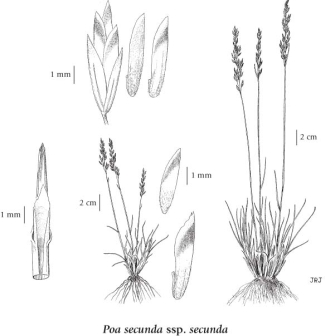Poa secunda J. Presl subsp. secunda
Sandberg's bluegrass
Poaceae (Grass family)
Introduction to Vascular Plants
Sandberg's bluegrass
Poaceae (Grass family)
Introduction to Vascular Plants
Map
Distribution of Poa secunda subsp. secunda
Click here to view the full interactive map and legend
Species Information
General:
Perennial, more or less densely tufted grass from fibrous roots; stems 15-120 cm tall.
Leaves:
Sheath margins open 3/4-9/10 their length; sterile shoots emerging inside sheaths and breaking through the sheath bases; blades 0.4-3 (5) mm wide, often glaucous (ssp. juncifolia), flat, folded, or in-rolled, thin or thick, smooth or rough; ligules 0.5-10 mm long, the tips blunt to long-pointed, the backs smooth or rough.
Flowers:
Inflorescence an erect, somewhat lax panicle, 2-25 cm long, usually moderately green or purplish, narrowly lanceolate to egg-shaped, congested, more or less open in flower and contracted at maturity, infrequently permanently open, some glaucous, the branches usually 1 to 3 per node, usually appressed or ascending, usually sparsely to distinctly rough on and between weakly developed angles, with spikelets in the terminal 1/2; spikelets weakly laterally compressed to nearly round, usually narrowly lanceolate, green or strongly purplish, 4-8 mm long, some glaucous, (2-) 3- to 10-flowered; glumes broadly lanceolate, the keels indistinct, the lower glumes 3-nerved; rachilla internodes usually exceeding 1 mm long, smooth or rough; lemmas lanceolate to narrowly lanceolate or slightly oblanceolate, weakly keeled, 3.5-5 mm long, the tips rounded to broadly sharp-pointed (with broad thin margins), hairless or minutely soft- to short silky-hairy on the keels and marginal nerves, hairless or hairy between the nerves; calluses hairless or with a crown of hairs up to 0.5 (2) mm long; palea keels rough, medially some minutely soft- or short silky-hairy; flowers bisexual; anthers 1.5-3 mm long.
Notes:
Two variable, facultatively apomictic subspecies occur in BC:
1. Lemmas smooth or minutely rough, at most crisp short-hairy on the nerves near the base; palea nerves rough; ligules all less than 2 mm long, squared-off to rounded, firm, rough on the backs.............. ssp. juncifolia (Scribn.) Soreng
1. Lemmas more or less short-hairy to silky-hairy on the nerves and between them, rarely smooth between the nerves; palea mostly silky-hairy on the nerves below and between them; ligules of at least the upper stem leaves more than 2 mm long, sharp-pointed to long-pointed, smooth or rough................. ssp. secunda
Illustration

If more than one illustration is available for a species (e.g., separate illustrations were provided for two subspecies) then links to the separate images will be provided below. Note that individual subspecies or varietal illustrations are not always available.
Illustration Source: The Illustrated Flora of British Columbia
Ecology
Ecological Framework for Poa secunda ssp. secunda
The table below shows the species-specific information calculated from
original data (BEC database) provided by the BC Ministry of Forests and Range.
(Updated August, 2013)
The table below shows the species-specific information calculated from
original data (BEC database) provided by the BC Ministry of Forests and Range.
(Updated August, 2013)
| Site Information |
Value / Class |
||
|
Avg |
Min |
Max |
|
| Elevation
(metres) |
859 | 92 | 2661 |
| Slope
Gradient (%) |
24 | 0 | 360 |
|
Aspect (degrees) |
199 | 0 | 360 |
| Soil
Moisture Regime (SMR) [0 - very xeric; 4 - mesic; 8 - hydric] |
2 | 0 | 8 |
| Modal
Nutrient Regime
Class |
C | ||
| #
of field plots species was recorded in: |
772 | ||
| Modal
BEC Zone Class |
BG | ||
|
All BEC Zones (# of stations/zone) species was recorded in |
AT(14), BAFA(3), BG(315), BWBS(1), CDF(4), ESSF(45), ICH(8), IDF(155), IMA(4), MS(11), PP(133), SBS(4), SWB(1) | ||
|
Source:
Klinkenberg 2013
|
|||
Habitat and Range
Dry to moist meadows and grasslands from the steppe to lower alpine zones; ssp. juncifolia - common in saline to alkaline meadows and grasslands to rich meadows in the steppe and montane zones; ssp. secunda - common on well-drained meadows and grasslands in the steppe and montane zones; N to extreme S AK, YT and NT, E to NF and S to MX, MI, MN, OK, NM, AZ and CASynonyms
Synonyms and Alternate Names:
Poa gracillima var. gracillima
